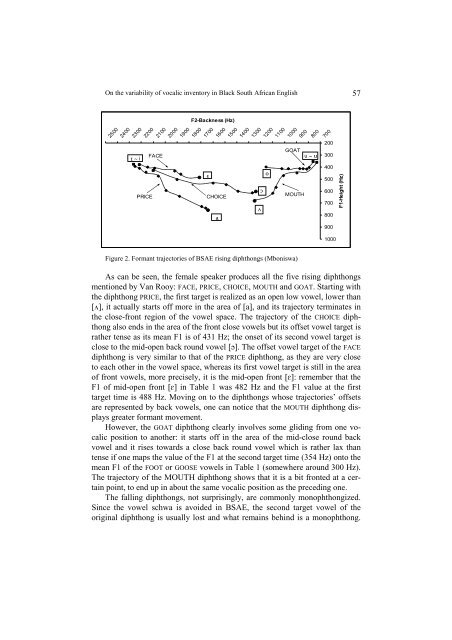s - Wyższa SzkoÅa Filologiczna we WrocÅawiu
s - Wyższa SzkoÅa Filologiczna we WrocÅawiu
s - Wyższa SzkoÅa Filologiczna we WrocÅawiu
Create successful ePaper yourself
Turn your PDF publications into a flip-book with our unique Google optimized e-Paper software.
On the variability of vocalic inventory in Black South African English 57<br />
2500<br />
2400<br />
2300<br />
Ǻ ~ i<br />
2200<br />
2100<br />
2000<br />
1900<br />
1800<br />
1700<br />
1600<br />
1500<br />
1400<br />
1300<br />
1200<br />
1100<br />
1000<br />
900<br />
800<br />
700<br />
PRICE<br />
FACE<br />
F2-Backness (Hz)<br />
ǫ<br />
CHOICE<br />
a<br />
Ȝ<br />
Ǥ<br />
o<br />
GOAT<br />
MOUTH<br />
u ~ Ț<br />
200<br />
300<br />
400<br />
500<br />
600<br />
700<br />
800<br />
900<br />
1000<br />
F1-Height (Hz)<br />
Figure 2. Formant trajectories of BSAE rising diphthongs (Mboniswa)<br />
As can be seen, the female speaker produces all the five rising diphthongs<br />
mentioned by Van Rooy: FACE, PRICE, CHOICE, MOUTH and GOAT. Starting with<br />
the diphthong PRICE, the first target is realized as an open low vo<strong>we</strong>l, lo<strong>we</strong>r than<br />
[ʌ], it actually starts off more in the area of [a], and its trajectory terminates in<br />
the close-front region of the vo<strong>we</strong>l space. The trajectory of the CHOICE diphthong<br />
also ends in the area of the front close vo<strong>we</strong>ls but its offset vo<strong>we</strong>l target is<br />
rather tense as its mean F1 is of 431 Hz; the onset of its second vo<strong>we</strong>l target is<br />
close to the mid-open back round vo<strong>we</strong>l [ɔ]. The offset vo<strong>we</strong>l target of the FACE<br />
diphthong is very similar to that of the PRICE diphthong, as they are very close<br />
to each other in the vo<strong>we</strong>l space, whereas its first vo<strong>we</strong>l target is still in the area<br />
of front vo<strong>we</strong>ls, more precisely, it is the mid-open front [ɛ]: remember that the<br />
F1 of mid-open front [ɛ] in Table 1 was 482 Hz and the F1 value at the first<br />
target time is 488 Hz. Moving on to the diphthongs whose trajectories’ offsets<br />
are represented by back vo<strong>we</strong>ls, one can notice that the MOUTH diphthong displays<br />
greater formant movement.<br />
Ho<strong>we</strong>ver, the GOAT diphthong clearly involves some gliding from one vocalic<br />
position to another: it starts off in the area of the mid-close round back<br />
vo<strong>we</strong>l and it rises towards a close back round vo<strong>we</strong>l which is rather lax than<br />
tense if one maps the value of the F1 at the second target time (354 Hz) onto the<br />
mean F1 of the FOOT or GOOSE vo<strong>we</strong>ls in Table 1 (somewhere around 300 Hz).<br />
The trajectory of the MOUTH diphthong shows that it is a bit fronted at a certain<br />
point, to end up in about the same vocalic position as the preceding one.<br />
The falling diphthongs, not surprisingly, are commonly monophthongized.<br />
Since the vo<strong>we</strong>l schwa is avoided in BSAE, the second target vo<strong>we</strong>l of the<br />
original diphthong is usually lost and what remains behind is a monophthong.
















